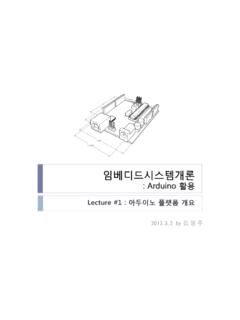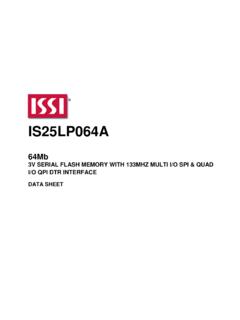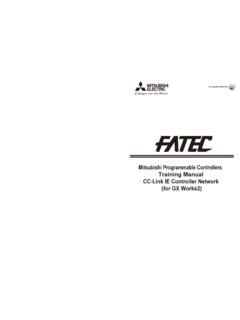Transcription of SST25VF016B - Microchip Technology
1 SST25VF016B . 16 Mbit SPI Serial Flash Features Product Description Single Voltage Read and Write Operations The 25 series Serial Flash family features a four-wire, - SPI-compatible interface that allows for a low pin-count Serial Interface Architecture package which occupies less board space and ulti- mately lowers total system costs. The SST25VF016B . - SPI Compatible: Mode 0 and Mode 3. devices are enhanced with improved operating fre- High Speed Clock Frequency quency and even lower power consumption than the - Up to 50 MHz original SST25 VFxxxA devices. SST25VF016B SPI. Superior Reliability serial flash memories are manufactured with propri- - Endurance: 100,000 Cycles (typical) etary, high-performance CMOS SuperFlash technol- - Greater than 100 years Data Retention ogy.
2 The split-gate cell design and thick-oxide tunneling injector attain better reliability and manufacturability Low Power Consumption: compared with alternate approaches. - Active Read Current: 10 mA (typical). - Standby Current: 5 A (typical) SST25VF016B devices significantly improve perfor- mance and reliability, while lowering power consump- Flexible Erase Capability tion. The devices write (Program or Erase) with a single - Uniform 4 KByte sectors power supply of for SST25VF016B . The total - Uniform 32 KByte overlay blocks energy consumed is a function of the applied voltage, - Uniform 64 KByte overlay blocks current, and time of application. Since for any given Fast Erase and Byte-Program: voltage range, the SuperFlash Technology uses less - Chip-Erase Time: 35 ms (typical) current to program and has a shorter erase time, the - Sector-/Block-Erase Time: 18 ms (typical) total energy consumed during any Erase or Program - Byte-Program Time: 7 s (typical) operation is less than alternative flash memory technol- ogies.
3 Auto Address Increment (AAI) Programming - Decrease total chip programming time over The SST25VF016B device is offered in both 8-lead Byte-Program operations SOIC (200 mils) and 8-contact WSON (6mm x 5mm). packages. See Figure 2-1 for pin assignments. End-of-Write Detection - Software polling the BUSY bit in Status Register - Busy Status readout on SO pin in AAI Mode Hold Pin (HOLD#). - Suspends a serial sequence to the memory without deselecting the device Write Protection (WP#). - Enables/Disables the Lock-Down function of the status register Software Write Protection - Write protection through Block-Protection bits in status register Temperature Range - Commercial: 0 C to +70 C.
4 - Industrial: -40 C to +85 C. Packages Available - 8-lead SOIC (200 mils). - 8-contact WSON (6mm x 5mm). All devices are RoHS compliant 2015 Microchip Technology Inc. DS20005044C-page 1. SST25VF016B . TO OUR VALUED CUSTOMERS. It is our intention to provide our valued customers with the best documentation possible to ensure successful use of your Microchip products. To this end, we will continue to improve our publications to better suit your needs. Our publications will be refined and enhanced as new volumes and updates are introduced. If you have any questions or comments regarding this publication, please contact the Marketing Communications Department via E- mail at We welcome your feedback.
5 Most Current Data Sheet To obtain the most up-to-date version of this data sheet, please register at our Worldwide Web site at: You can determine the version of a data sheet by examining its literature number found on the bottom outside corner of any page. The last character of the literature number is the version number, ( , DS30000000A is version A of document DS30000000). Errata An errata sheet, describing minor operational differences from the data sheet and recommended workarounds, may exist for current devices. As device/documentation issues become known to us, we will publish an errata sheet. The errata will specify the revision of silicon and revision of document to which it applies.
6 To determine if an errata sheet exists for a particular device, please check with one of the following: Microchip 's Worldwide Web site; Your local Microchip sales office (see last page). When contacting a sales office, please specify which device, revision of silicon and data sheet (include literature number) you are using. Customer Notification System Register on our web site at to receive the most current information on all of our products. DS20005044C-page 2 2015 Microchip Technology Inc. SST25VF016B . BLOCK DIAGRAM. FIGURE 1-1: FUNCTIONAL BLOCK DIAGRAM. SuperFlash X - Decoder Memory Address Buffers and Latches Y - Decoder I/O Buffers Control Logic and Data Latches Serial Interface CE# SCK SI SO WP# HOLD#.
7 1271 2015 Microchip Technology Inc. DS20005044C-page 3. SST25VF016B . PIN DESCRIPTION. FIGURE 2-1: PIN ASSIGNMENTS. CE# 1 8 VDD CE# 1 8 VDD. SO 2 7 HOLD# SO 2 7 HOLD#. Top View Top View WP# 3 6 SCK WP# 3 6 SCK. VSS 4 5 SI VSS 4 5 SI. 1271 08-wson QA 1271 08-soic S2A 8-Lead SOIC 8-Contact WSON. TABLE 2-1: PIN DESCRIPTION. Symbol Pin Name Functions SCK Serial Clock To provide the timing of the serial interface. Commands, addresses, or input data are latched on the rising edge of the clock input, while output data is shifted out on the falling edge of the clock input. SI Serial Data Input To transfer commands, addresses, or data serially into the device. Inputs are latched on the rising edge of the serial clock.
8 SO Serial Data Output To transfer data serially out of the device. Data is shifted out on the falling edge of the serial clock. Outputs Flash busy status during AAI Programming when reconfigured as RY/BY#. pin. See Hardware End-of-Write Detection on page 11 for details. CE# Chip Enable The device is enabled by a high to low transition on CE#. CE# must remain low for the duration of any command sequence. WP# Write Protect The Write Protect (WP#) pin is used to enable/disable BPL bit in the status register. HOLD# Hold To temporarily stop serial communication with SPI flash memory without resetting the device. VDD Power Supply To provide power supply voltage: for SST25VF016B . VSS Ground DS20005044C-page 4 2015 Microchip Technology Inc.
9 SST25VF016B . MEMORY ORGANIZATION used to select the device, and data is accessed through the Serial Data Input (SI), Serial Data Output (SO), and The SST25VF016B SuperFlash memory array is orga- Serial Clock (SCK). nized in uniform 4 KByte erasable sectors with The SST25VF016B supports both Mode 0 (0,0) and 32 KByte overlay blocks and 64 KByte overlay eras- Mode 3 (1,1) of SPI bus operations. The difference able blocks. between the two modes, as shown in Figure 4-1, is the state of the SCK signal when the bus master is in DEVICE OPERATION Stand-by mode and no data is being transferred. The SCK signal is low for Mode 0 and SCK signal is high for The SST25VF016B is accessed through the SPI (Serial Mode 3.)
10 For both modes, the Serial Data In (SI) is sam- Peripheral Interface) bus compatible protocol. The SPI. pled at the rising edge of the SCK clock signal and the bus consist of four control lines; Chip Enable (CE#) is Serial Data Output (SO) is driven after the falling edge of the SCK clock signal. FIGURE 4-1: SPI PROTOCOL. CE#. MODE 3 MODE 3. SCK MODE 0 MODE 0. SI Bit 7 Bit 6 Bit 5 Bit 4 Bit 3 Bit 2 Bit 1 Bit 0 DON'T CARE. MSB. HIGH IMPEDANCE. SO Bit 7 Bit 6 Bit 5 Bit 4 Bit 3 Bit 2 Bit 1 Bit 0. MSB 1271 Hold Operation HOLD# signal does not coincide with the SCK active low state, then the device exits in Hold mode when the The HOLD# pin is used to pause a serial sequence SCK next reaches the active low state.














